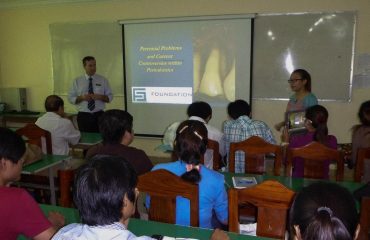Article by Dr John Carrigy MDSc (Melb), BDS (Syd) Hons, MRACDS (Perio)
DOWNLOAD: Dr John Carrigy Periodontist Talk Notes
TAKE HOME POINTS
The treatment of Periodontitis follows a set path of clinical action. These “phases” of treatment may differ in their name and number – but the goals of each step are almost universally accepted :
- SYSTEMIC PHASE
- HYGIENIC PHASE
- Formal Review
- Additional Therapy
- CORRECTIVE PHASE
- SUPPORTIVE PHASE
This systematic approach to the treatment of periodontitis means that the dental clinician is in an ideal position to assist in the identification of the patient suffering from “incipient” or “pre-diabetes” as well as assist in the education and management of the patient already diagnosed with the condition. Early diagnosis and management of diabetes is critical to limit the myriad of systemic complications that result from chronic hyperglycemia. These include a range of macro-vascular and micro-vascular effects as well as ‘up regulation’ of many inflammatory mediators. Numerous studies in the dental literature have confirmed that poorly controlled diabetics are more likely to develop periodontitis, and that the disease is more severe.
Conversely, in a well controlled diabetic – the response to periodontal therapy is non-diabetic clinician is in an ideal position to assist in the identification of the patient suffering from “incipient” or “pre-diabetes” as well as assist in the education and management of the patient already diagnosed with the condition. Early diagnosis and management of diabetes is equivalent to a patient.
In a reciprocal manner, it has also been confirmed that well treated and ‘stable’ periodontal health will assist a diabetic patient in achieving glycemic control.
SIGNS & SYMPTOMS
What to look for – what to ask
Although differing in their aetiology – both periodontitis and diabetes have chronic inflammation as a central feature of their pathogenesis. So it is not surprising that periodontal disease may be the first sign that ‘all is not well’. The clinician should be particularly on alert if :
- The onset of the periodontal issues have been relatively rapid
- Symptoms are acute (eg. multiple periodontal abscesses)
Symptoms that may also alert the clinician to a possible underlying diabetic condition include :
excessive thirst, dry mouth / cramps, fatigue, polyuria, hunger, unexplained weight changes, feeling unwell / dizzy, slow healing, persistent skin infections, blurred vision, Irritability / mood swings or headaches.
If diabetes (or pre-diabetes) is suspected then the importance of further investigation by their medical practitioner must be EMPHASISED STRONGLY to the patient – as the morbidity (and mortality) from diabetes is significant (eg. cardiovascular disease, nephropathy, retinopathy, neuropathy).
ACUTE COMPLICATIONS
Although “Diabetic Ketoacidosis” and a “Hyperglycemic hyperosmolar state” are life threatening emergencies for the diabetic patient (and every dental clinician should be aware of their symptoms) – they usually develop over a longer time frame of days or weeks and are therefore less likely to come to a crisis in the dental chair. By far the most frequent complication seen in the dental setting from diabetes is Hypoglycemia. Signs and symptoms of hypoglycemia include : confusion, shakiness (tremors), agitation, tachycardia, dizziness and nausea (eventually progressing to panic, loss of consciousness and seizures)
Anxiety about a dental procedure or ‘skipping a meal’ before a dental appointment are two common reasons this problem is seen in the dental chair. Also, the clinician should be aware that adrenalin in many local anesthetics may mimic or mask the above hypoglycemic symptoms. Patients who have been a diabetic for many years and are “well controlled” are particularly susceptible to ‘missing’ the signs of developing hypoglycemia.
Treatment for a mild hypoglycemic episode can be delivered at the chair side. This involves getting a simple carbohydrate (15 – 20 g) into the patient. Usually a high sugar content fruit juice or soft drink with a straw is the easiest approach. Glucose sweets or jelly beans are another option. All dental clinics should have these on hand for such emergencies.
If the patient cannot take oral sugar – then 30-40 ml of a 50% dextrose solution may need to be injected intravenously or a subcutaneous or intramuscular injection of glucagon given. In any event, this may be better administered by paramedics – and thus an ambulance should be called.
PERIODONTAL TREATMENT STEPS
Definitions:
Diabetes mellitus – is a clinically and genetically heterogeneous group of metabolic disorders manifested by abnormally high levels of glucose in the blood.
1.1 million Australians are currently diagnosed with Diabetes – many more remain undiagnosed.
Periodontitis:
Periodontal Disease – is the term that diseases that affect one or more of the periodontal tissues. The most is often used to describe a “group of common of these is the “plaque induced inflammatory conditions”
Australian Research Report no. 50 – 2010. Confirmed 24.2% of Australians suffer from moderate to severe periodontitis, This is just under 5 1⁄2 million people.




